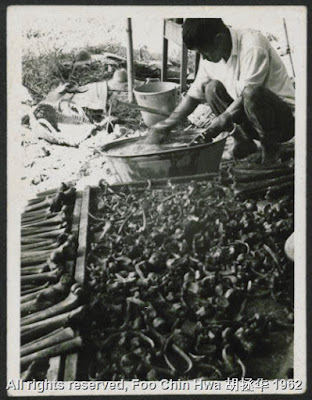There was a series of pictures that were recently published on PictureSG, donated by Foo Chin Hwa 胡拯华 1962 that got me curious. It was a series of pictures that shows and describes exhumation being carried out and bones found in Siglap. However nothing further was added in the description and credit line of this pictures except for a few. For this series of pictures, a few things were consistent, the year the pictures were taken and the donor, Foo Chin Hwa 胡拯华.
 |
| source: PictureSG |
 |
| Bones found in Siglap (source: PictureSG) |
 |
| Piles of discarded footwear source: PictureSG |
 |
| Storing bones in jar (source: PictureSG) |
Siglap's "Valley of Death"
The newspaper article headline of 24 February 1962 caught my attention. It describes a recent sandwashing activity at 7.5 mile Siglap Road which led to a discovery of mass war graves. The location of this place is off Evergreen Avenue and very close to Puay Poon School. The Chinese Chamber of Commerce set-up a 3 man committee to organise the retrieval of the remains. This was led by Mr. Ng Aik Huan, Mr. Toh Keng Tuan and Lam Thian. Further digs led to discovery of 40 more mass graves and another two mass graves were found at 10.5 milestone along Changi Road where claims of a 1,000 were machine-gunned and buried. |
| Mass War Graves Found (source: NewspaperSG) |
 |
| source: NewspaperSG |
Eye Witness Accounts
From the article, stories of how the mass grave came about started to unraveled. Mr. Chue Choon Kwee, 72 years old (in 1962) and a farmer living near the area shared how the Japanese forced him and 30 other villages to dig five trenches each . Once done, the villages were chased out of the area. He however, hid among the bushes on a hilltop. Choon Kwee witness and counted 66 lorries entering the valley and each lorry carried about 60-70 civilian internees. They were lined up by the trenches and machine-gunned.Mr. Lai Siang Yong, 62 (now a principal of a Chinese School) was one of the lucky survivor from the massacre. He recounted how he was part of a large group who were rounded up and later transferred from a concentration camp at Lorong 3 Geylang and brought to Siglap. They were tied in groups of six each and when the firing began, he managed to break loose the bonds and ran to hide in the bushes. Although hit in his thigh, he survived.
Ngo Yong Seng, 63, principal of Puay Poon School which is situated 100 yards from the site was forced to dig graves before being driven off. Three days later he returned to see bodies heaped in the graves with loose sand over them. A week after the shooting, the Japanese brought labourers to cover the graves with more earth.
Aftermath - Civilian War Memorial
Prime Minister Lee Kuan Yew announced in March 1962 that the Singapore government had asked the British government to seek amends and atonement from the Japanese government, in connection with the massacre committed by the Japanese during the war. There was also a suggestion that a memorial park be built at Siglap for those massacred by the Japanese during the war, if the Japanese would make compensation. On 13 March 1963, the Singapore government announced that it would set aside 4.5 acres of land along Beach Road for the building of a memorial park to commemorate the civilian victims massacred during the Japanese Occupation. The memorial was completed in January 1967 at a cost of approximately $500,000. Before its completion, a ceremony was held on 1 November 1966, during which 606 urns containing the remains from the mass graves were interred on either side of the memorial podium. The President of the Chinese Chamber of Commerce, Soon Peng Yam led a large gathering of mourners in observing a 3 minute silence. The Civilian War Memorial was officially unveiled by Prime Minister Lee Kuan Yew on 15th February 1967. |
| Urns being interred (source: NewspaperSG |
 |
| War memorial is unveiled (source: NewspaperSG) |
References
Mass War Graves found in Siglap's Valley of Death. (1962, February 24). The Straits Times.
Ceremony at New War Memorial. (1966, November 2). The Straits Times
War Memorial is unveiled. (1967, February 16). The Straits Times, page 17
Ceremony at New War Memorial. (1966, November 2). The Straits Times
War Memorial is unveiled. (1967, February 16). The Straits Times, page 17
Urns,Siglap[1]. Foo, Chin Hwa. PictureSG
Man washing bones, 1962 [2]. Foo, Chin Hwa. PictureSG
Bones and skulls in two baskets. Foo, Chin Hwa. PictureSG
Man putting bones into urns. Foo, Chin Hwa. PictureSG.
Five skulls on tray. Foo, Chin Hwa. PictureSG.
Piles of discarded footwear. Foo, Chin Hwa. PictureSG.
Civilian War Memorial. Vernon Cornelius-Takahama. Singapore Infopedia.
Man washing bones, 1962 [2]. Foo, Chin Hwa. PictureSG
Bones and skulls in two baskets. Foo, Chin Hwa. PictureSG
Man putting bones into urns. Foo, Chin Hwa. PictureSG.
Five skulls on tray. Foo, Chin Hwa. PictureSG.
Piles of discarded footwear. Foo, Chin Hwa. PictureSG.
Civilian War Memorial. Vernon Cornelius-Takahama. Singapore Infopedia.
Comments
Post a Comment
Thank you for your comment. I can also be reached at rojaklibrarian@gmail.com